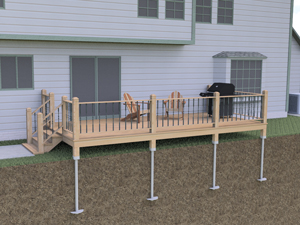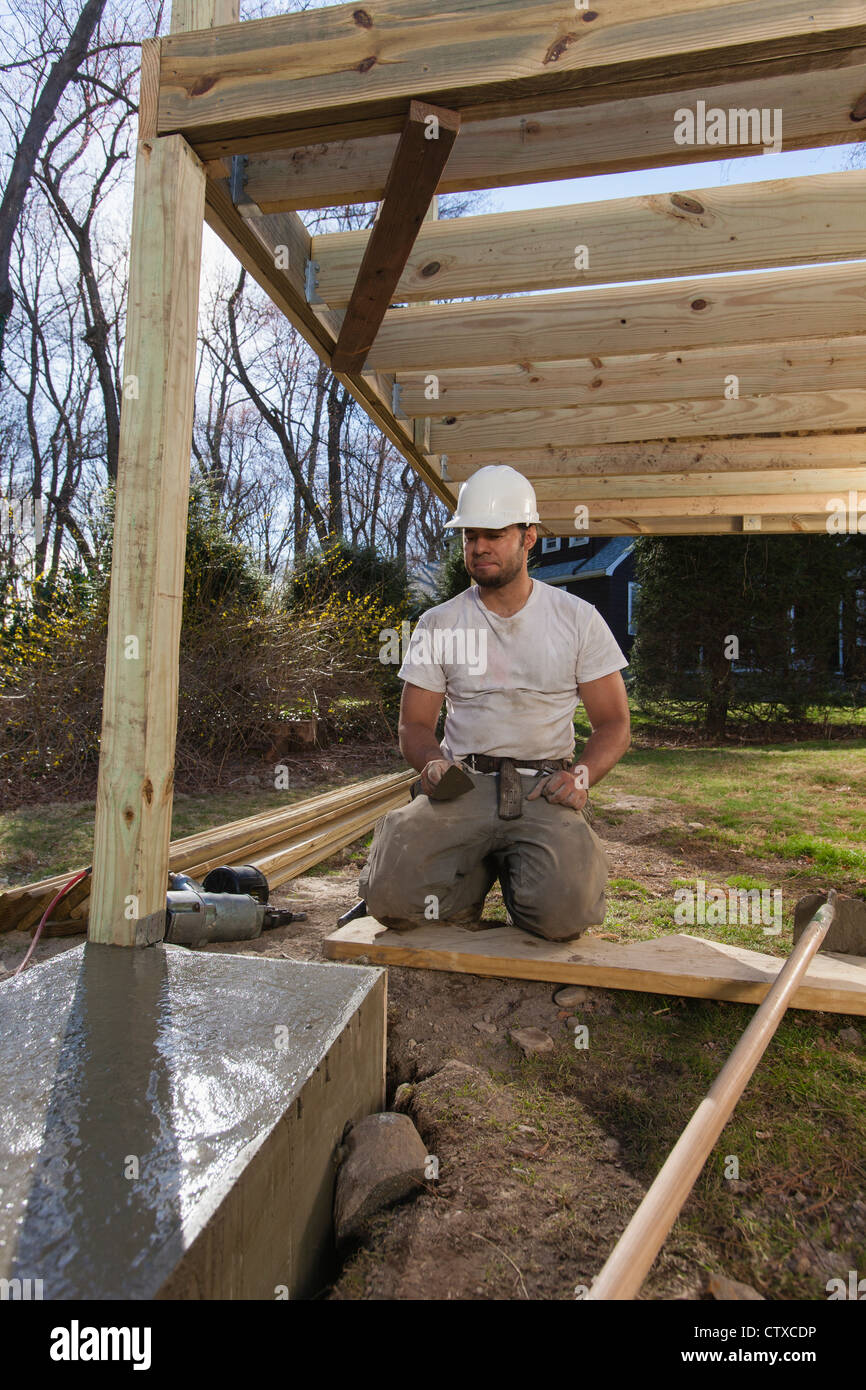Selecting the Right Deck Footings for Security and Sturdiness
The long life and security of your deck depend greatly on the type of grounds you choose, as they supply the crucial support and stability to hold up against the examination of time. In this discussion, we will discover the various types of deck footings, think about the crucial aspects to evaluate when making a choice, and delve right into the pros and cons of different alternatives.
Sorts Of Deck Grounds
There are numerous kinds of deck footings that can be used, each offering one-of-a-kind advantages and considerations. One usual sort of footing is the concrete pier ground. These footings include a cylindrical hole loaded with concrete, which offers a strong structure for the deck articles. Concrete pier grounds are relatively easy to set up and use exceptional security, making them a prominent option for lots of deck tasks.
An additional kind of footing is the helical stack footing. Helical stacks are steel shafts with helical plates affixed to them. These footings are mounted by screwing them right into the ground, which develops a protected foundation for the deck. Helical heap grounds are excellent for locations with challenging soil conditions, as they can be mounted in virtually any kind of kind of dirt. They additionally permit easy change and progressing of the deck if needed.
Additionally, some home builders choose precast concrete footings. These grounds are made of sturdy concrete and be available in various sizes and shapes to accommodate various deck designs. Precast concrete grounds are convenient to mount and give a stable base for the deck framework.
Lastly, an additional option is the post-in-anchor ground system. This type of ground includes driving a metal support right into the ground and connecting it to the deck post. It uses flexibility in regards to placing the deck posts and is appropriate for decks with lightweight structures.
When choosing the best kind of deck footing, it is vital to think about factors such as soil conditions, deck tons, and neighborhood building codes (Deck Footings). Consulting with an expert service provider or architectural engineer can assist make certain the suitable ground is chosen for a secure and secure deck
Elements to Take Into Consideration When Picking Grounds
When picking the suitable grounds for a deck, it is crucial to very carefully consider numerous variables such as soil conditions, deck tons, and adherence to regional building codes. These elements play a substantial duty in ensuring the stability and toughness of the deck structure.
Among the key variables to take into consideration is the soil conditions. The sort of dirt on which the deck will be developed figures out the type of grounds called for. Decks constructed on loosened or sandy dirts might call for deeper footings to offer sufficient support and avoid settling. On the other hand, decks improved clay or expansive dirts might require footings that can accommodate the dirt's propensity to broaden and contract.
An additional important factor is the deck lots. The weight of the deck, including the materials made use of and any type of possible real-time tons such as furniture or celebrations, need to be taken into consideration when choosing footings. The grounds need to be developed to birth the weight of the deck and disperse it uniformly to stop any architectural issues or failings.
Finally, adherence to neighborhood structure codes is critical. Building codes differ from area to region, and it is necessary to adhere to the specific demands set by the regional authorities. Deck Footings. These codes ensure that the deck is developed securely and meets the essential standards for architectural honesty and load-bearing capability
Concrete Grounds: Pros and Cons

When utilized as the structure for a deck,Concrete grounds supply several advantages and downsides. On the positive side, concrete grounds give excellent stability and toughness. Concrete is a solid and rigid product that can support heavy loads and stand up to various weather. It additionally has a lengthy lifespan, making it a trustworthy selection for long-lasting use.
Another advantage of concrete footings is their flexibility. They can be poured into various sizes and shapes to accommodate numerous deck layouts and arrangements. Concrete grounds can be personalized to fit the certain demands and demands of the deck structure.
However, there are likewise some drawbacks to using concrete grounds. This can increase the total expense of the deck project and might need professional help.

Helical Piers Vs. Sonotubes: Which Is Better?
In taking into consideration the structure alternatives for a deck, the contrast in between helical piers and sonotubes is essential in figuring out the premium selection. Helical piers, additionally called screw heaps, are steel shafts with helical plates connected to find here them. They are turned into the ground using hydraulic machinery, providing a stable and durable foundation for the deck. On the various other hand, sonotubes are round forms constructed from cardboard or fiber product that are filled up with concrete. They are placed in an opening explored the ground and offer support for the deck.
The helical plates on the piers develop a solid grasp with the dirt, avoiding any kind of motion or changing of the deck. Sonotubes, on the other hand, count entirely on the concrete loading for security, which may not supply the exact same degree of news strength and resistance.
In regards to installation, helical piers are reasonably easier and faster to mount compared to sonotubes. The hydraulic machinery made use of to twist the piers into the ground guarantees a fast and efficient process. Sonotubes, on the other hand, call for excavating holes and pouring concrete, which can be taxing and labor-intensive.
Furthermore, helical piers are an even more versatile choice. They can be utilized in various dirt problems and can be readjusted or reinforced if needed. Sonotubes, on the other hand, might call for additional support, such as rebar, in specific soil problems or locations with high lots needs.
Picking the Right Footings for Your Deck's Dimensions
For optimal structural stability, it is vital to very carefully pick the ideal grounds that align with the dimensions of your deck. The dimensions of your deck, including its height, size, and size, play a considerable role in identifying the type and size of footings called for.
When selecting grounds for your deck, it is essential to think about the load-bearing ability of the dirt. The weight of the deck, incorporated click with the weight of any kind of furniture or individuals on it, applies a substantial pressure on the footings (Deck Footings). It is important to select footings that can adequately sustain this weight without moving or sinking over time.
The size and form of the grounds must also be considered. Bigger decks with better dimensions call for bigger grounds to offer sufficient security and support. The shape of the footings, whether they are square or rounded, depends upon the design and format of the deck. Furthermore, the depth at which the footings are installed need to be figured out based on the frost line in your area to avoid any heaving or shifting as a result of freezing temperature levels.
Conclusion
In conclusion, choosing the right deck grounds is vital for guaranteeing security and durability. Factors such as the type of grounds, the deck's measurements, and the pros and disadvantages of various alternatives must be considered.
These footings consist of a cylindrical hole filled with concrete, which offers a solid structure for the deck posts. Concrete pier footings are relatively easy to install and provide outstanding stability, making them a popular choice for many deck projects.
Precast concrete footings are convenient to install and offer a stable base for the deck structure.
It provides flexibility in terms of positioning the deck posts and is ideal for decks with light-weight structures.
Concrete footings offer numerous benefits and negative aspects when made use of as the foundation for a deck.